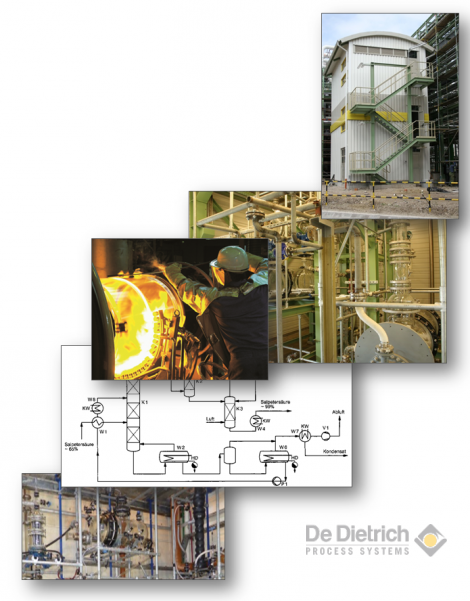High concentration of sulfuric acid
- Purification of spent sulfuric acid -
- Environmental friendly recycling -
- Savings on raw material and waste disposal
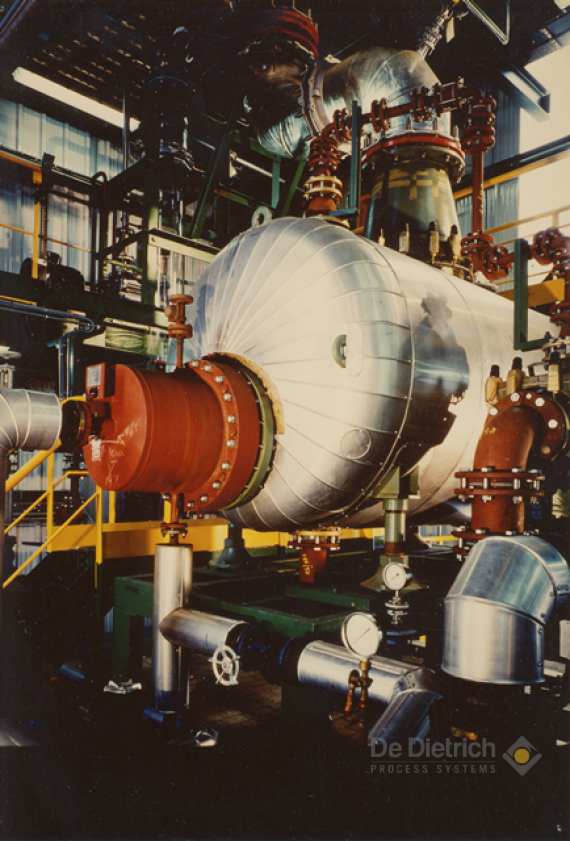

Proven QVF® Process realized with reliable equipment
of De Dietrich Process Systems.
Highlights
- Feed rate from 100kg/h up to 145t/h
- Reconcentration up to 98 wt%
- Low acid concentration in condensate < 1%
- Customised design to suit available utilities
- QVF® S.A.C. Process
- Components from own production of De Dietrich Process Systems
- Minimum maintenance
- More than 250 installations world wide
Module for high concentrated sulfuric acid
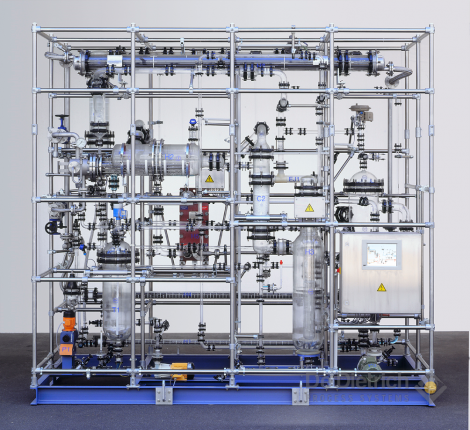
Process
The concentration of sulphuric acid is essentially the evaporation of water. Any non volatile impurities as salts will remain in the acid and may potentially precipitate and so that they can be withdrawn from the evaporator. Non volatile organic impurities either decompose during the concentration process or will have to de decomposed before entering the QVF® Horizontal Boiler. A common diluted feed stream for the recovery of high concentrated sulfuric acid is e.g a sulfuric acid comming from a chlorine drying process with a concentration of 74-78%wt. The concentration process is carried out under vacuum in order to decrease the boiling temperature. This is necessary to avoid any corrosion and to enable the use of steam (typically at 13-17barg) as heating media for the tantalum tubed heat exchangers. The optimum process vacuum is chosen with respect to the temperature difference between the heating steam and the boiling acid as well as the temperature of the cooling agent. As an alternative to heating steam electrical quartz heating sticks can be used.
To concentrate from say 66% the process would be carried out in two stages, the first vacuum evaporation stage up would provide up to 88-90%wt and a second stage at an even lower vacuum giving the final concentration of high concentrated sulfuric acid.
Because of the acidity of the vapours from the high concentrated boiling sulphuric acid, it is necessary to scrub the vapours. This is done in a column above the evaporator with the fed diluted sulfuric acid. The concentration of sulfuric acid in the condensate is mainly determined by entrained aicd droplets and is less than 1%wt.
As an example of good engineering practice and to minimsie operating costs energy recovery is realised by preheating the cold feed with the concentrated liquid hot sulfuric acid leaving the evaporator.
The vapours are condensed in corrosion resistant condensers.
If the acid waste stream is not satifactorily well defined to permit a process liability we will be pleased to carry out test runs with your waste stream in our test facility to insure the required product qualities and reliable operation.
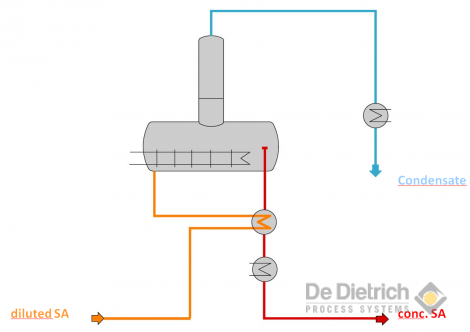
Equipment description
Sulfuric acid concentration plants from De Dietrich Process Systems are designed for maximum efficiency with an optimum of minimum investment and operating cost. The plant construction is of course adapted to the special requirements to concentrate highly corrosive sulfuric acid up to 98 wt%:
- Reduction of operation pressure to decrease the evaporation temperature far enough to permit the use of steam as heating media.
- Reduction of the acid content in the condensate by using the QVF® horizontal boiler and a scrubbing column
- The selection of the suitable material combination is crucial for this process. Only few materials are resistant against concentrated sulphuric at temperaures above 200°C. Therefore all equipment in contact with the acid is manufactured from borosilicate glass 3.3, glass-lined steel, PTFE, tantalum or quartz for a long life time.
Vacuum generation
The main vacuum resp. the vacuum of the first stage is generated by using the condensate as liquid either with a liquid ring pump or more corrosion resistant setup. For an eventually required lower vacuum at the second evaporation stage a jet pump is employed using steam.
Vacuum generation with corrosive liquid condensate
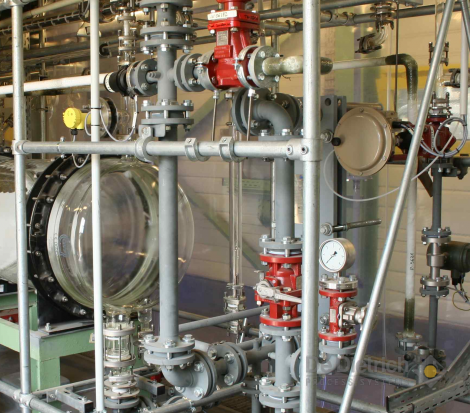
Jet pumps on flash pot DN1000
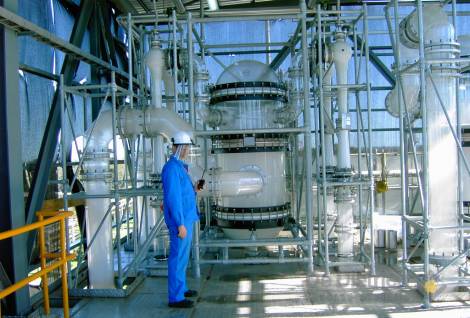
Heat Recovery, Cooling and Condensation
The diluted feed acid is pre-heated with hot concentrated sulfuric acid in a heat exchanger which is corrosion resistant on both media sides. A perfect solution for this process step are the QVF® shell and tube heat exchangers. They consists of
- Tubes made of SiC- or borosilicate glass ,
- Shell and header made of and glass-lined or borosilicate glass 3.3
- Tube plate made of PTFE or PTFE/PVDF with embedded stainless steel plate
- PTFE sealings screws and gaskets.
For further cooling of the concenrated sulfuric acid and condensation of the acidic water the shell and tube heat exchangers must be corrosion resistant only on the shell side so that stainless stell covers and and support plates can be used on the cooling water side permitting a cooling water pressure of up to 6bar.
QVF® SUPRA - Shell and tube heat exchanger - corrosion resistant on tube and shell side
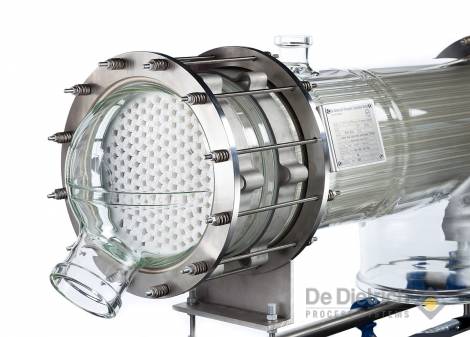
QVF® SUPRA - Shell and tube heat exchanger - corrosion resistant on shell side
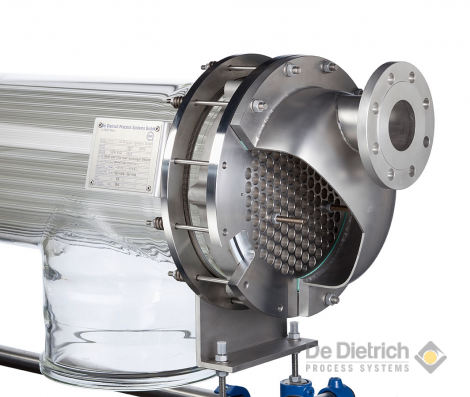
QVF® Horizontal Boiler
DeDietrich Process systems developed this type of evaporator since the 1970´ys. It mainly consist of a bundle of bayonette type Tantatum heating sticks in the lower part of a laying horizontal evaporator shell made, depending on size, either of borosilicate glass 3.3 or glass-lined steel. The diluted sulfuric acid enters the shell near the header of the bayonette type heating stick bundle. The diluted acid flows then while being concentrated towards the outlet of the evaporator shell where the heating sticks end. On their way out through the horizontal boiler the acid flows through baffles that separate the horizontal boiler body into differnent stages. As the baffles avoid back mixing a temperature profile due to the concentration profile in the evaporator unfolds. This increases the average temperature difference between steam and acid and hence minimises the required heat transfer area means minimises the costs for the Tanatalum heating sticks.
The acidity of the vapour rises virtually exponentially with the acid concentration, the vapours generated at the front end of the QVF® Horizontal Boiler have an acidity in the region of 1 ppm, compared to almost 3% at the end and discharge of the QVF® Horizontal Boiler for the above concentrations. This leads to a further advantage of the QVF® Horizontal Boiler as it reduces the acidity in the leaving vapours, which gives lower acid losses and reduced effluent treatment cost.
In addition since everything is internal, there are no circulation lines or circulation pumps handling hot concentrated sulphuric acid, reducing maintenance costs and risk of failure.
Depending on the difference between the concentration in the feed and in the product one, two or three evaporator stages operating at different vacuum levels offer the optimum solution. Under ideal conditions the QVF® Horizontal Boiler can employed for concentrations up to 98% sulfuric acid otherwise quartz heating sticks will be foreseen.
QVF® Horizontal boiler with glass shell and a Tantalum heater bundle.
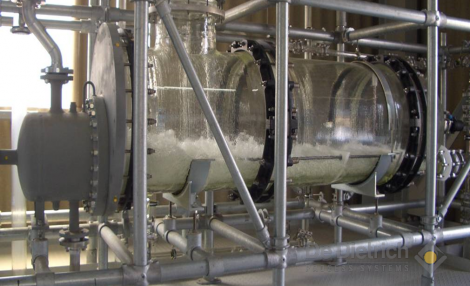
QVF® Horizontal boiler with a glass-lined shell and a Tantalum heater bundle.
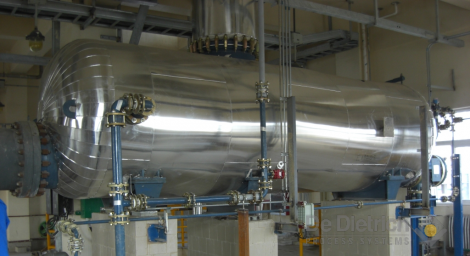
Scheme of QVF® Horizontal glass-lined boiler and temperature profile
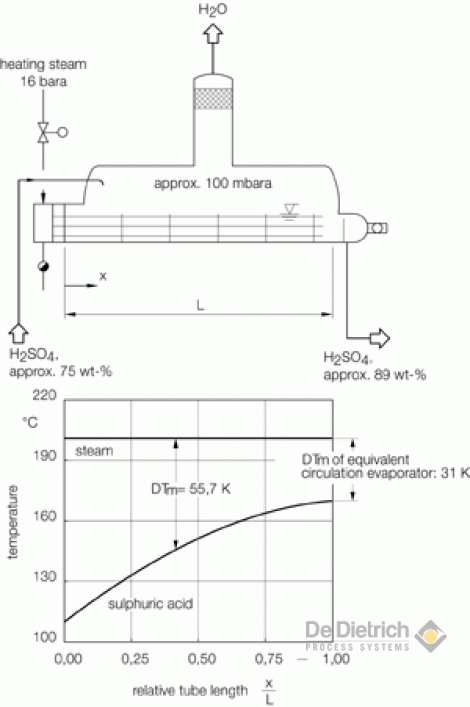
Advantages of the QVF® Horizontal Boiler:
- Low fluid level above the heating surfaces means reduced hydroctatic pressure and hence improved evaporation rates.
- Low hold up in the evaporator for safe and flexible operation - turndown ratio from 25% to 100% without loss of performance.
- Reduced acid content in the vapour phase due to the temperature gradient along the evaporator
- Increaseed mean temperature difference between steam and acid reducing the amount of required tantalum heating sticks
- Low design height of evaporator.
- Evaporator without pump and minimum flange connections eases maintenance and increases reliablitity
Scrubbing column
The column consists of components as column sections, distributors, column packing, support trays being developped by De Dietrich Process Systems over decades.
In order to minimize the concentration of sulfuric acid in the condensate the up-rising vapours from the evaporator are scrubbed with the feed acid entering at the top of a scrubbing column. The feed acid is equally distributed over the full cross area of the column packing by means of distributors of different QVF® types depending on the column size and throughput. The column packing has to combine a high corrosion resistance, a high separation efficiency with a low permissible pressure drop. In most cases the QVF® DURAPACK is therefore the ideal choice. This inhouse column packing is a patented structured packing made of borosilicate glass 3.3.
Feed distributor in QVF® DURAPACK column
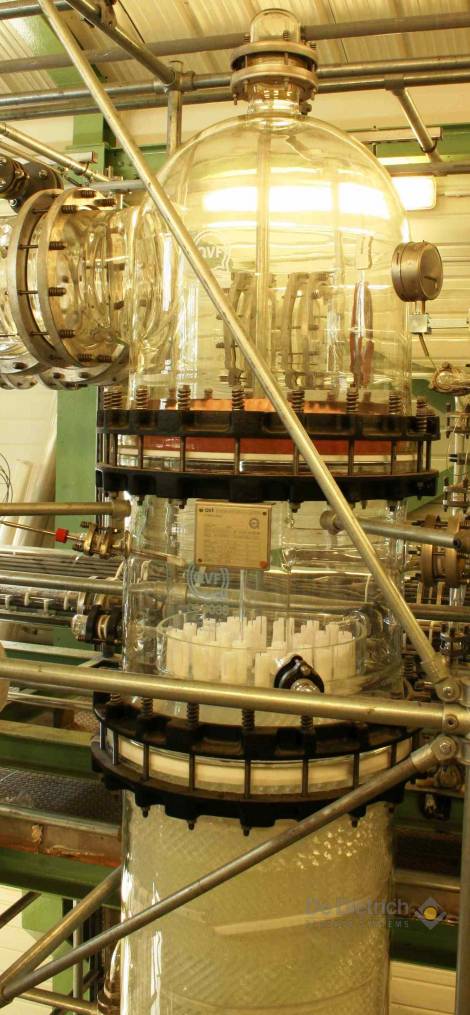
QVF® DURAPACK structured packing made of borosilicate glass 3.3
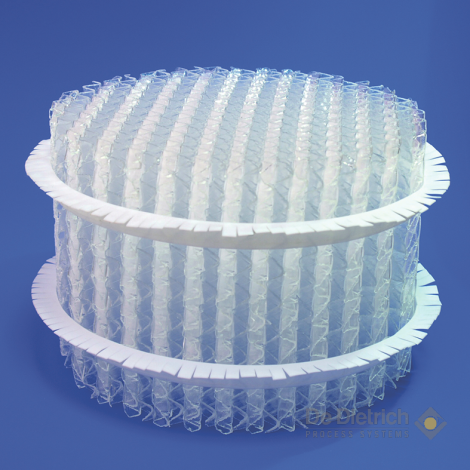
.
Services
- Process liability
- Documentation
- Commissioning
- Installation
- Transportation
- Manufacturing
- Procurement
- Detailed Engineering
- Risk analyses
- Basic Engineering
- Feasibility studies
- Tests and Trials
